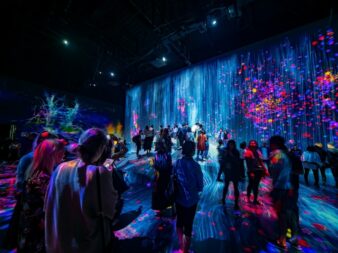Museums are more than simply a place for visitors to browse and soak in culture. They offer a wealth of programming, community outreach efforts, research support, and other ways in which they contribute to building society and serving humanity.
Supporting up-and-coming artists is one of the many ways museums can make an impact. That’s why forward-thinking venues often round out their programming with an onsite residency program that gives chosen artists the studio space, materials, and promotional support to progress in their careers.
There are several concrete reasons that an artist residency program can give a museum a boost as well as the artist. Here's why...
What is an artist residency program?

Artist residency programs are designed to cultivate artists and give them an immersive opportunity to work on their creative craft in a new environment. Removed from the distractions and burdens of everyday life, artists can devote themselves to developing new ideas, sharpening skill sets, and honing their craft.
Residents are given a cloistered environment in which they can focus entirely on their artworks. But at the same time, the museum residence is not typically a solitary experience.
In fact, it’s the ability to interact with other professionals in the art world as well as patrons of the museum that makes this a truly unique and compelling experience for both up-and-coming and established artists.
Also sometimes called an artist-in-residence program or simply artist residency, this type of offering is a natural fit for museums looking to elevate their brand whilst helping cultivate artists and exhibit contributors of tomorrow.
Six advantages of hosting an artist residency program
1. Create community engagement
The Rijksakademie is an institution in Amsterdam that sponsors a group of artists for two years at a time. A highly in-demand program, it’s not unusual for a few thousand people to apply to this residency, although only around 20 are chosen each year. Those fortunate few are supported with studio space, housing, technical advising, and workshops.
Open studios are periodically held, where residents show their work – in progress or finished – and members of the community have a chance to be inspired by the creative genius at play within Rijksakademie.
It’s a highly international medium. As one recipient, visual artist, and performer Otobong Nkanga, describes it, “There are many artists coming from different parts of the world, which allows for the artists to mingle with other artists, and it also has a very important international standing.”
Bringing together an international community of artists to one site, and inviting the community in to witness their work, is just one way that Rijksakademie lives up to its mission of “reflecting the diversity of contemporary art practice.”
If community is important to your museum, whether that means a focus on the local community or a gathering of the global, an artist residency program is a potent way to achieve this goal.
2. Spotlight up-and-coming artists

The Museum of Arts and Design in NYC (MAD) has an artist-in-residence program housed on the sixth floor of its building in Midtown Manhattan. Three artists are sponsored for six months at a time, and the program specifically focuses on recruiting and cultivating NYC-based artists from historically underrepresented communities.
While “in residence,” chosen artists work in the museum’s designated studio space and receive a stipend. Residents of MAD’s program have gone on to exhibit not only at MAD, but at other major museums including the Queens Museum, Whitney Museum, Brooklyn Museum, and Studio Museum.
Their foundational experience as museum residents at MAD becomes a defining aspect of their lives as artists — something that also raises MAD’s brand value as a result.
For art museums, bringing in new and fledgling artists is one way to cultivate talent, support the arts, and align themselves with tomorrow’s most widely recognized talents. Not all museum residencies are geared toward up-and-coming artists, but they represent a strong sector of the target audience.
3. Format new experiences for visitors

While artists are in residence at MAD, visitors to the museum are encouraged to visit them in their studio space and witness art in production.
This priceless opportunity to witness work in progress is a valuable one for visitors – and for the museum, which can count this experience among its dynamic visitor offerings.
For the artists, it gives them a chance to engage with their audience and gain their reactions to artwork as it’s being created - a win-win-win type of situation.
If your museum plans to invite the public into its artist residency studio space, it’s wise to consult with the artists on the timing and cadence of this opportunity. Few artists could work productively with constant interruptions. MAD, for instance, schedule visitors only three days a week during certain hours.
4. Sponsor new exhibits and artworks
For museums, one of the biggest benefits of an artist-in-residency program is the opportunity to cultivate new artworks and exhibits specifically designed for the museum’s collection.
At the Victoria & Albert Museum in London (known as the V&A), contemporary artists are typically brought in for nine-month residences. During this time, residential artists are encouraged to “experiment and disrupt.”
Sculptor Rebecca Stevenson, for one, made contemporary artwork that reflected the museum’s Medieval & Renaissance collections. Her residency was timed to coincide with an exhibit called Donatello: Sculpting the Renaissance, which explored the talents of “the greatest sculptor of all time,” whose work was created around the turn of the 15th century.

By juxtaposing the artworks of a historical master and a contemporary artist, the esteemed museum put itself at the center of a relevant modern discussion about art.
Also in London, the National Gallery launched its own artist-in-residence program, now in its third year. The 2023 recipient, Céline Condorelli, is working toward a showing in September 2023 to showcase her “imaginary architectural interventions,” which reference “the notions of leisure and labor in society.” As part of her residency, Condorelli is also researching the Gallery’s collection and history.
In many of these cases – and as a hallmark of artist residencies – the artists work in reference to the museum content while they are participating in the program, creating a new, reflective type of work the museum can proudly present.
As a sponsoring museum, it’s your job to tread the fine line between inviting artists to comment on or contribute to your collection – but at the same time, giving them creative liberty to work in their own way.
5. Contribute to a more diverse society of makers and doers
The Royal Museums Greenwich partnered with art organization the Collective Makers to improve diversity within the art sector and raise artist profiles as part of their residency program.
Unlike most residencies, which recruit individual artists, this partnership is unique. The Royal Museums Greenwich and the Collective Makers leverage each other’s strengths to further their respective missions.
Of course, diversity, equity, and inclusion are important levers for most artist residency programs today. It’s smart practice for museums in general to have a published statement about their diversity pillar, stating the aims of their culture, recruitment practices, and accessibility efforts.
There are a lot of facets to diversity, and many museums strive to differentiate their efforts in this domain. One way to do so is with a well-executed artist residency program that cultivates a diverse array of talent.
6. Become PR-worthy!
The final benefit of artist residencies is more like a bonus. By instituting an artist residency program at your museum, you avail your institution of potential positive public relations and marketing opportunities.
An opportunity to gain good PR is a given, but it has to be anchored in real work. Beware the trap of touting your artist residency before it’s proven itself. Put together a program that is truly authentic and valuable to the community. Good PR will follow naturally.
Interested in setting up a program? Here's a few things to consider:

- Space: Most importantly, you need to have a space that can be devoted to the program. Small urban museums may have to get creative in this way.
- Investment: Artist residencies also require some capital. In addition to space, you will probably need to invest in desks, tables, and other furnishings, as well as artist supplies. Typically, a museum employs someone to oversee the program, whether it’s their full-time job or an offshoot of an existing role. Managing and marketing an artist residency program takes time, and time is, of course, money.
- Budgeting: There’s also another budgetary element. Many artists in residence receive a stipend, plus there are the costs of promoting the program and the artists. Before you launch your residency program, map out that budget and what it will truly require.
- Mission: Determine your motivation for forming an artist residency, and let that data inform the overarching mission.
Like any truly creative endeavor, an artist residency program will be a work in progress. You’ll learn as you go, and that learning will help your program grow.
Interested in more ways to innovate your museum and bring it firmly up to speed with modern cultural expectations? Read 5 Ways to Become a More Sustainable Museum in 2023.



